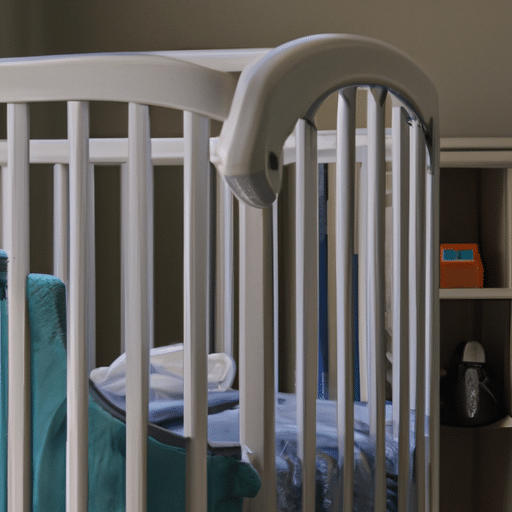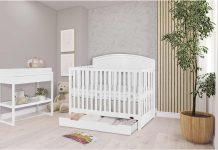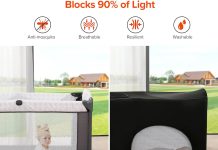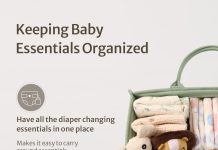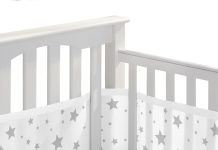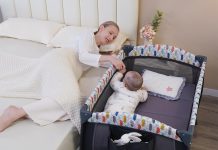Curious about the rules for using a crib at an in-home daycare? Well, look no further! In this article, we’ll explore everything you need to know about the regulations surrounding cribs in these childcare settings. Whether you’re a parent, a caregiver, or simply interested in understanding the guidelines, stay with us to discover the essential information on providing a safe and comfortable sleep environment for little ones.
Review contents
Safety Guidelines for Using a Crib
As providers of an in-home daycare, ensuring the safety and well-being of the children in our care is our highest priority. One key aspect of this responsibility is providing a safe sleep environment for infants and toddlers. In order to maintain the highest level of safety, it is important to follow proper guidelines for using a crib. From selecting a safe crib to regular safety checks, here are some essential safety guidelines to keep in mind.
Selecting a Safe Crib
When it comes to choosing a crib for your in-home daycare, safety should be the primary consideration. Ensure that the crib meets the current safety standards set by regulatory bodies such as the Consumer Product Safety Commission (CPSC). Look for cribs with fixed sides as opposed to drop-side cribs, as they pose a risk of entrapment or injury. Additionally, check for any recalls or safety warnings associated with the crib model.
Placement and Location
The placement and location of the crib also play a vital role in ensuring the safety of the children. The crib should be positioned away from windows, blinds, and cords to eliminate the risk of strangulation or entanglement. Avoid placing the crib near any other furniture that a child could potentially climb on. Ensure that there are no hanging decorations, such as mobiles, within the reach of the child.
Safe Mattress and Bedding
A safe mattress and appropriate bedding are essential for a secure and comfortable sleep environment. The mattress should fit snugly in the crib without any gaps or spaces along the edges. Opt for a firm mattress that meets safety standards to reduce the risk of suffocation. When it comes to bedding, avoid using soft pillows, blankets, or stuffed animals in the crib. The safest option is to utilize a fitted sheet specifically designed for the crib mattress.
Proper Assembly and Maintenance
Proper assembly of the crib is crucial to ensure its stability and safety. Follow the manufacturer’s instructions carefully, and double-check that all screws, bolts, and other components are securely fastened. Regularly inspect the crib to identify any loose or broken parts, and promptly repair or replace them as needed. Maintain the crib’s condition by keeping it clean and free from any hazards.
Regular Inspections and Safety Checks
Regular inspections and safety checks should be conducted to guarantee the ongoing safety of the crib. Inspect the crib for any signs of wear, damage, or loose components on a routine basis. Check that the mattress is properly placed and that the crib is free from any objects that could pose a risk to the child. By performing these regular checks, you can promptly address any safety concerns and maintain a safe sleep environment.
Sleeping and Napping Policies
Establishing appropriate sleep and nap routines is crucial for the overall well-being and development of children in our in-home daycare. In addition to following safety guidelines, it is essential to establish policies that promote healthy sleep habits and prevent sudden infant death syndrome (SIDS) in infants. By implementing the following measures, we can create a safe, nurturing, and restful sleep environment for the children.
Establishing Sleep and Nap Routines
Consistency is key when it comes to establishing sleep and nap routines. Establish set nap times and durations that are appropriate for the different age groups in your daycare. Create a calm and quiet environment conducive to sleep, ensuring that all children have a comfortable and designated space to sleep. By following consistent routines, children are more likely to feel secure and relaxed, resulting in better sleep quality.
SIDS Prevention Measures
SIDS, the sudden and unexplained death of an infant under one year of age, is a deeply concerning issue. As caregivers, we can take steps to minimize the risk of SIDS in our in-home daycare. Place infants on their backs to sleep, as the supine position has been proven to reduce the incidence of SIDS. Ensure that the crib mattress is firm and that there are no loose or soft objects in the crib that can obstruct the infant’s breathing.
Supervision and Monitoring
While infants and toddlers are napping, it is important to have consistent supervision to ensure their safety. Maintain an open line of sight or use a reliable baby monitor to keep a watchful eye on sleeping children. Regularly check on napping children to ensure they are in safe positions and not experiencing any difficulties. By providing close supervision during sleep and nap times, we can promptly address any potential safety concerns.
Transitioning from Crib to Bed
As children grow, there will come a time when they outgrow the crib and need to transition to a bed. The timing of this transition may vary for each child, but it is essential to follow safety guidelines when making the switch. Ensure that the child’s new bed is age-appropriate, with proper safety features such as guardrails. Educate parents on the importance of implementing bed safety measures, such as securing furniture to the wall and using appropriate bedding.
Health and Hygiene Guidelines
Maintaining a clean, hygienic, and comfortable environment is vital for the health and well-being of the children in our in-home daycare. Incorporating health and hygiene guidelines into our daily routines not only promotes cleanliness but also helps prevent the spread of illnesses. By following the guidelines outlined below, we can create a safe and healthy space for the children to sleep.
Cleanliness and Sanitation
Regular cleaning and sanitation of the crib and sleep area is crucial to prevent the buildup of germs and bacteria. Clean and disinfect the crib mattress and surfaces regularly, particularly when transitioning between children in care. Pay attention to high-touch areas such as the mattress, railing, and knobs. Use child-safe cleaning products as recommended by health authorities to ensure the safety of the children.
Proper Positioning and Posture
Maintaining proper positioning and posture while sleeping is important for the overall comfort and well-being of the children. Ensure that infants are placed on their backs, as this position minimizes the risk of suffocation and promotes healthy development. For older children, encourage a comfortable sleeping posture that supports their natural spinal alignment.
Comfortable Temperature and Ventilation
The temperature and ventilation in the sleep area play a significant role in the comfort and safety of the children. Maintain a comfortable room temperature between 68 to 72 degrees Fahrenheit (20 to 22 degrees Celsius). Ensure proper ventilation to prevent the build-up of stale air and allergens. Regularly check the room temperature and adjust as necessary to create a conducive sleep environment.
Emergency Preparedness
No one wants to think about emergencies, but as caregivers, it is our responsibility to be prepared for any unforeseen circumstances. Establishing proper emergency preparedness protocols ensures the safety of the children in our care and provides peace of mind to both parents and ourselves. By following the guidelines outlined below, we can respond effectively and efficiently to any emergency situation.
Crib Safety Training for Caregivers
It is crucial for all caregivers to receive proper training in crib safety, emergency procedures, and first aid. This training equips us with the knowledge and skills necessary to respond quickly and appropriately in case of an emergency. Regularly review and refresh our knowledge through training sessions and workshops to stay up to date with the latest safety practices.
Emergency Evacuation Plans
Having a well-defined emergency evacuation plan is essential in ensuring the safety and well-being of the children. Develop a detailed evacuation plan that includes designated assembly areas, emergency contact information, and alternative transportation arrangements if necessary. Regularly practice drills to familiarize both caregivers and children with the evacuation procedures.
Communication with Parents and Emergency Contacts
Maintaining open and transparent communication with parents and emergency contacts is crucial during emergencies. Ensure that all contact information is up to date and readily accessible. Establish a reliable means of communication, such as a designated emergency contact person or a group messaging system, to keep parents informed and updated in case of emergency situations.
Licensing and Regulatory Requirements
As providers of an in-home daycare, it is important to comply with all applicable local, state, and federal laws and regulations. These regulations are in place to ensure the safety, well-being, and quality of care for the children entrusted to us. Familiarize yourself with the licensing requirements specific to your location, and ensure that you have all the necessary certificates and documentation to operate legally.
Compliance with Local, State, and Federal Laws
Stay informed about the specific laws and regulations that govern the operation of in-home daycares in your area. This may include requirements related to crib safety, emergency preparedness, staff-to-child ratios, health and safety standards, and more. Regularly review and update your policies and procedures to align with any changes in the laws or regulations.
Certificates and Required Documentation
Ensure that you have obtained all the necessary certificates and documentation to operate legally as an in-home daycare. This may include licenses, permits, background checks, and health and safety inspections. Display these documents prominently in your daycare area to assure parents that you are operating in compliance with regulatory standards.
Age and Developmental Considerations
Children of different ages and developmental stages have varying needs and requirements when it comes to crib usage. As caregivers, it is important to understand these differences and provide appropriate care that meets the individual needs of each child. By considering age and developmental factors, we can ensure the safety and well-being of the children in our in-home daycare.
Appropriate Crib Usage by Age Group
Different age groups have different requirements when it comes to crib usage. Infants should be placed on their backs to sleep in a crib with a firm mattress, whereas older children may require additional safety features such as guardrails in their beds. Stay informed about the latest guidelines and recommendations for crib usage based on age groups to ensure the optimal safety and comfort of the children.
Supervision of Infants and Toddlers
Infants and toddlers require close supervision due to their increased vulnerability and lack of coordination. Ensure that caregivers closely monitor sleeping infants and toddlers to ensure their safety. Regularly check on them, maintain an open line of sight, and respond promptly to any signs of distress or discomfort. By providing vigilant supervision, we can prevent accidents and respond quickly to any potential safety concerns.
Individual Needs and Comfort
Each child is unique and has their own individual needs and comfort preferences. Some children may require additional support or accommodations, such as specialized mattresses or positioning devices, due to medical conditions or developmental considerations. Take into account each child’s individual needs when providing crib usage and ensure that they have a safe and comfortable sleep environment tailored specifically for them.
Putting Safety First
As caregivers, the safety of the children in our in-home daycare is our utmost priority. By making safety a priority, we create an environment where children can thrive and parents can have peace of mind. Here are some key measures we can take to put safety first.
Safe Sleep Education for Parents
Education is crucial in promoting safe sleep practices. Provide parents with educational materials and resources that highlight safe sleep guidelines and practices. Encourage open conversations with parents about their child’s individual needs and concerns regarding sleep. By empowering parents with knowledge and information, we can work together to ensure the safety and well-being of the children.
Access to Resources and Information
Stay informed about the latest research, guidelines, and resources related to crib safety and child care. Regularly review reputable sources and organizations that provide information on safe sleep practices. By being knowledgeable and up to date, we can continuously improve our practices and provide the best possible care for the children in our in-home daycare.
Staff Training and Professional Development
Investing in staff training and ongoing professional development is essential for maintaining a high level of safety in our in-home daycare. Regularly provide training sessions on topics such as crib safety, emergency procedures, first aid, and age-appropriate care. Encourage staff to pursue additional certifications or qualifications to enhance their skills and knowledge. By prioritizing staff training, we ensure that all caregivers are equipped with the necessary tools to provide a safe environment for the children.
Safe Crib Practices
In addition to following the guidelines discussed earlier, there are some specific safe crib practices that can further enhance the safety and well-being of the children in our care. By incorporating these practices, we can minimize potential hazards and create a secure sleep environment.
No Loose or Soft Objects in the Crib
Avoid placing any loose or soft objects in the crib, as they can pose a suffocation risk. This includes pillows, blankets, stuffed animals, and other similar items. Instead, provide a fitted sheet, and dress the child appropriately for the climate to ensure they are comfortable during sleep.
Proper Use of Crib Bumpers and Mobiles
If using crib bumpers, ensure that they are specifically designed for that purpose and securely attached to the crib according to the manufacturer’s instructions. However, it is important to note that crib bumpers are not recommended due to the potential risk of suffocation and entanglement. When it comes to mobiles, consider their potential risks and ensure they are securely attached out of reach of the child.
Safe Handling of Crib Accessories
When using crib accessories, such as sleep positioners or wedge pillows, ensure that they are specifically designed for that purpose and recommended by health authorities. Follow the manufacturer’s instructions regarding their proper use and placement. Regularly check for any signs of wear or damage and promptly replace as necessary.
Crib Maintenance and Disposal
Maintenance and proper disposal of cribs are essential for maintaining safety standards and ensuring the well-being of the children. Establishing routine cleaning and maintenance practices, as well as proper disposal methods for damaged or recalled cribs, is crucial.
Regular Cleaning and Disinfecting
Regularly clean and disinfect the crib, mattress, and all surfaces according to health and safety guidelines. Remove any debris or spills promptly and use child-safe cleaning products. Pay special attention to high-touch areas and ensure that all cleaning materials are properly rinsed off before allowing the child to use the crib again.
Retirement of Damaged or Recalled Cribs
Regularly inspect the crib for any signs of damage or wear, such as loose parts, cracks, or splinters. If any damage is identified, promptly repair or replace the crib to maintain its safety and integrity. Stay informed about any crib recalls and promptly remove any recalled cribs from use. Follow the manufacturer’s instructions regarding the proper disposal or return of recalled cribs.
Environmentally-Friendly Disposal
When the time comes to retire a crib that is no longer safe or needed, consider environmentally-friendly disposal methods. If possible, dismantle the crib and recycle any recyclable materials. If disposing of the crib entirely, follow local guidelines for proper disposal. By disposing of cribs responsibly, we contribute to a sustainable and safer environment for future generations.
Communication with Parents
Maintaining open and transparent communication with parents is crucial in providing the best care for the children and ensuring their safety. By establishing effective communication channels and practices, we can address any concerns, provide vital information, and work together to create a safe and nurturing environment for the children.
Providing Crib Safety Information
Regularly provide parents with information and resources related to crib safety. This can include safe sleep guidelines, updates on any changes in the sleep environment, and recommendations for safe sleep practices at home. By keeping parents informed and involved, we create a collaborative partnership that prioritizes the well-being of the children.
Notification of Changes or Incidents
Promptly notify parents of any changes or incidents related to crib safety that occur during daycare hours. This includes changes in sleep routines, incidents of discomfort or distress during sleep, or any damage or recalls related to the crib. Transparent communication allows parents to stay informed about their child’s well-being and enables them to address any concerns or take necessary action.
Open and Transparent Communication
Establish a welcoming and open atmosphere where parents feel comfortable discussing any concerns or suggestions related to crib safety. Encourage open dialogue and actively listen to any feedback or questions parents may have. By fostering open and transparent communication, we build trust and confidence with parents, ensuring that their child’s safety and well-being are always our top priority.
In conclusion, adhering to safety guidelines for using a crib is essential for providers of in-home daycares. By selecting a safe crib, following appropriate placement and location practices, ensuring a safe mattress and bedding, and conducting regular inspections, we create a secure sleep environment for the children. Additionally, implementing proper sleeping and napping policies, focusing on health and hygiene guidelines, being prepared for emergencies, complying with licensing requirements, and considering age and developmental factors further enhance the safety and well-being of the children. By putting safety first, practicing safe crib usage, properly maintaining and disposing of cribs, and maintaining open communication with parents, we create a safe, nurturing, and reassuring environment for the children in our care.

